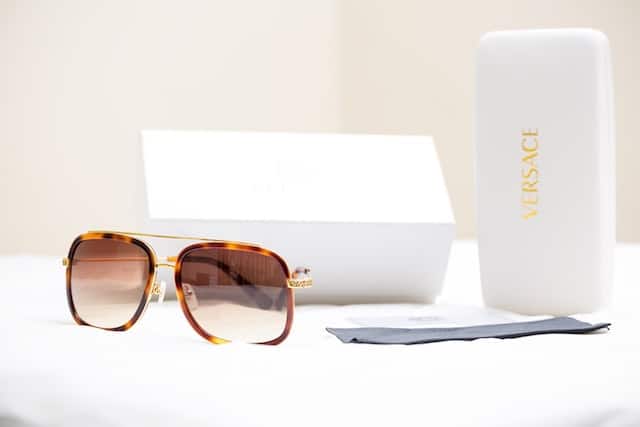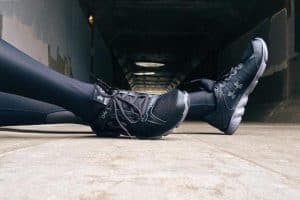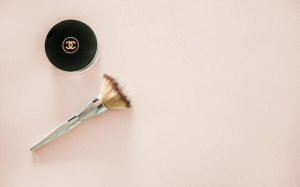Unique styles and eye-catching statement pieces are the hallmarks of both Gucci and Versace. Items that can transform an outfit from drab to fab, such as clothing, perfumes, sunglasses, handbags, and more, are available from both labels. Both brands are Italian, and their newest collections are regularly showcased at fashion weeks worldwide. But which luxury brand offers more bang for the buck, Gucci or Versace? This Gucci vs Versace article compares these iconic fashion brands in depth by delving into their history, facts, and marketing strategies.
Gucci vs Versace- An Overview
As previously stated, both Gucci and Versace are Italian fashion powerhouses that essentially sell the same things.
What Are They?
Pronounced “GUC-chee,” Gucci is an Italian fashion house based in Florence that specializes in high-end luxury goods. The name Gucci is synonymous with the highest quality leather goods, haute couture, timepieces, and jewelry. Items for the home and body are also available. Its products epitomize the pinnacle of handcraft due to their innovation, originality, aesthetic quality, and attention to detail.
Gianni Versace S.r.l., commonly shortened to Versace and pronounced “Versach-EH,” is an Italian luxury fashion house founded by Gianni Versace in 1978. The Atelier Versace label features both high-end and ready-to-wear accessories made in Italy as well as haute couture creations. Its reputation for cutting-edge style and high-society ambiance precedes it.
Common products from both brands include:
- Sunglasses
- Bags
- Sandals
- Fragrances
- Jewelry
Gucci vs Versace- Market Cap
Kantar’s BrandZ 2022 Top 30 Most Valuable Italian Brands rating uses financial data and brand equity research to determine a brand’s worth, and Gucci has once again claimed the top spot. The fashion company remains at the top of the list for the fourth consecutive year, with a brand value of $37.9 billion, up 12% from $2021. The Florentine design firm reported three times the value of the Italian utility company Enel, which ranked in the bottom two.
Comparably reports that the Capri Holdings brand, the parent company of Versace, is ranked #64 on the list of the Global Top 100 Brands, which is compiled based on ratings provided by Versace customers. The most recent estimate places their value at $7.46 billion. According to Yahoo! Finance, Capri Holdings has a market capitalization of approximately $6.38 billion as of September 7, 2022.
Style and Aesthetics in Gucci vs Versace
While Gucci isn’t as extreme as, say, Versace, the brand enjoys playing with prints. They’re a bit more all over the place, but they put a lot of emphasis on basic garments covered in logos and designs. Gucci customers tend to be young and forward-thinking. While most of Versace’s collections include bold patterns and bright colors, the label also produces classic staples that may be updated with the right accessories. Versace frequently uses bright hues and eye-catching patterns, notably gold. The Barocco or baroque print is one of Versace’s most well-known creations; it brings to mind Ancient Rome and Greece.
What Is in the Logo?
Both Gucci and Versace are household names around the world, and their emblems are instantly recognizable because of their commitment to high-end materials and skilled production. The Versace emblem is far more complex and incorporates the famous Greek mythological figure Medusa’s head. There are several variations on the Gucci monogram. To begin, the brand’s name has double G’s underneath, which is commonly seen on beauty items and fragrances. Secondly, there is the plain double G, prominently displayed in the company’s Marmont collection; and third, there is the brand’s name without the double G’s.
The next Gucci vs. Versace sections focus on the history of both brands, which is an excellent starting point for learning about them.
Gucci History
Here is a detailed report about the history of Gucci.
Founding
Guccio Gucci founded Azienda Individuale Guccio Gucci to sell imported leather luggage. The store was located on Via Della Vigna Nuova in Florence. He also set up a modest studio where neighborhood artisans could make his custom leather products. The League of Nations imposed a trade embargo on Italy in 1935 due to Mussolini’s invasion of Ethiopia. Due to a lack of raw materials, Guccio Gucci began incorporating materials like raffia, wicker, wood, linen, and jute into his goods. Gucci first sold its handbags to the public in 1937. Son Aldo persuaded his father Guccio to expand the business by building a second store in Rome that year, and he also introduced new Gucci accessories. Gucci’s skilled workers made combat footwear for the Italian infantry during World War II. Guccio Gucci distributed the company shares to his three sons, Aldo, Vasco, and Rodolfo, after the war. In 1952, Gucci debuted their now-iconic moccasin, five years after introducing the Bamboo tote. On January 2, 1953, Guccio Gucci passed away in Milan.
Gucci in the United States, London, Asia, and the Middle East
Gucci’s first U.S. store opened its doors in November 1953 in New York City. New Yorkers began referring to the neighborhood around 5th Avenue and 54th Street as “Gucci City” after a second store opened in the Saint Regis Hotel in 1960. By 1961, Gucci had built shops in both London and Palm Beach, and the brand’s signature Jackie Bag had made its debut. Gucci’s first French store, located close to Place Vendôme, opened in March 1963. As a result of Gucci’s opening at 347 Rodeo Drive in October 1968, several famous actors and actresses began wearing and promoting the label. Gucci expanded to other parts of the world, including the Middle East and Asia, with the launch of a Tokyo store in 1972 and a Hong Kong location in 1974.
Gucci Perfumes and the Roll-Royce Luggage
During the 1970s, Gucci introduced a set of Rolls-Royce luggage and collaborated with American Motors Corporation to release a special edition of the AMC Hornet. In 1972, Gucci introduced its first perfume (Il Mio Profumo) and its first watch (Model 2000). In 1973, it opened its first franchised store in the United States. In 1977, it opened the Gucci Galleria in its Beverly Hills store, a private art gallery adjoining the store that was reserved for premium clients who were given a golden key to enter.
Gucci Family Feud
The first family feud began in 1969 when Aldo’s son Giorgio started Gucci Boutique on his own. The company was eventually incorporated back into the family in 1972. In 1982, the Gucci family business was merged into a single publicly traded company called Guccio Gucci SpA in an effort to reduce friction within the family. Rodolfo passed away in May of 1983. After inheriting his father’s controlling interest in the company, Maurizio Gucci went to court to displace his uncle Aldo as the company’s sole owner. Maurizio Gucci sold around 48.2% of the company to the Bahrain-based investment fund Investcorp in 1988 while keeping 50% for himself. Despite the family feuds, Gucci branded goods sales reached $400 million between 1981 and 1987 and $227 million in 1990. In 1993, Investcorp purchased Maurizio Gucci’s remaining 50% stake in Guccio Gucci S.p.A., effectively ending the family’s role in the company.
Dawn Mello and Tom Ford
In 1989, Gucci hired Dawn Mello as chief designer and executive vice president. To restore the luxury image of the business, she cut the number of outlets from more than a thousand to just 180. She also reduced the number of Gucci products to 7,000 from 22,000. Gucci hired Tom Ford as the creative director in 1994. Ford and Mello dug into the company’s history from the 1970s, released several controversial products, including silver handcuffs and a G-string, and ran controversial advertising campaigns. After taking over as CEO of Gucci in 1994, Domenico De Sole increased the company’s advertising expenditure from $6 million in 1993 to $70 million in 1997 and reassessed the prices of all Gucci products. In October 1995, the firm was publicly indexed on the New York Stock Exchange with an initial stock value set at US$22. Then, from 1995 to 1997, Investcorp sold its holdings in Gucci for roughly US$1.9 billion.
The LVMH Scare
French luxury goods firm LVMH began stealthily purchasing Gucci shares in 1995, and by January 1999, LVMH owned 34% of Gucci Group NV. Tom Ford and Domenico De Sole needed to get out from under LVMH’s thumb, so they went to French financier François Pinault and his company Pinault Printemps Redoute, which eventually morphed into Kering. Pinault’s company purchased 40% of Gucci at $75 per share in March, diluting LVMH’s holdings to 20.7%. The agreement also included PPR’s acquisition of Yves Saint Laurent from Sanofi and subsequent resale of the brand to the Gucci Group at the same sum. This coup d’état in the fashion business sparked a cold war between LVMH and the new Gucci-PPR combination. There was friction between the two companies when, in December of 2000, Gucci purchased 51% of Alexander McQueen’s couture house when McQueen was also the creative designer for LVMH’s Givenchy. In September 2001, all parties involved in the Gucci dispute settled out of court. Tom Ford and Domenico De Sole’s contract with Gucci-PPR expired in April 2004. Three designers who had worked under Ford’s creative direction—John Ray, Alessandra Facchinetti, and Frida Giannini—were kept on by Gucci Group after his departure to ensure the success of the company’s main label. For its 90th anniversary, the firm opened the Gucci Museum (Gucci Museo) in Florence in 2011. With the addition of 220 additional stores between 2010 and 2015, Gucci now has 500 locations worldwide.
Gucci’s Renaissance
Marco Bizzarri, formerly of Bottega Veneta, was appointed CEO of Gucci in December 2014. Alessandro Michele was named Gucci’s creative director in January 2015 by then-owner and designer Marco Bizzarri. Alessandro Michele debuted “a distinct Gucci” with a “sophisticated, cerebral, androgynous feel” at the February 2015 Fall presentation. Gucci’s new Milan headquarters, the Gucci Hub, was opened in the former Caproni aerospace factory in September 2016. Gucci made its debut in the home decor industry in July 2017 with the introduction of Gucci Décor. All novel leather items, footwear, new materials, metal hardware, and packaging are designed and tested at Gucci’s ArtLab, which opened in April 2018. The Gucci Wooster Bookstore, stocked with a collection of books selected by Dashwood Books’ David Strettell, opened in New York in November 2018. Gucci’s revenue for 2019 was 9.6 billion euros. Due to a deal between Kering and Alibaba, Gucci opened two stores (fashion and beauty) on Tmall in December 2020. Gucci introduced its Hollywood Forever eyewear collection in May of 2021.
Versace
We now delve into the history of Versace!
Founding
The first Versace store, dubbed “Gianni Versace Donna,” debuted in Milan’s Via della Spiga that same year, 1978. When it came to his brand, Versace was unusual among designers in that he handled every aspect, from creation to distribution, himself. In 1982, the firm branched out into other markets, including the accessory, jewelry, home furnishing, and china sectors. Donatella Versace launched her “Young Versace” and “Versus” collections in 1993, and the black Versace dress worn by Elizabeth Hurley—infamously known as “that dress”—brought the label global attention in 1994. Versace’s reputation as the “Rock n’ Roll designer” stems from the fact that the label has dressed such celebrities as Elton John and Michael Jackson. When Elton John toured in 1992, Versace created his stage outfits and album cover costumes. The Princess of Wales and Princess Caroline of Monaco have both worn apparel designed by Versace. The Versace brand is well-known for consistently repurposing its runway models for its advertising campaigns.
Was It a Family Affair?
Donatella Versace, who had been vice president, became creative director after the assassination of her brother Gianni in 1997. Santo Versace, Gianni’s older brother, assumed the role of chief executive officer. Donatella Versace handed her daughter Allegra Versace a controlling interest in the business, which she took over when she turned eighteen. Following Hurley’s 1994 dress as the “most iconic dress of all time,” Jennifer Lopez’s “green Versace dress” from the 42nd Annual Grammy Awards in 2000 came in at number five in a Daily Telegraph survey in 2008.
Versace Rennaissance
In 2003, with profitability falling, the Versace Group brought in Fabio Massimo Cacciatori as interim CEO to reorganize and restructure the company. Cacciatori quit citing “disputes with the Versace family” in December of 2003. Giancarlo di Risio of IT Holding served as the group’s CEO from 2004 to 2009, when he resigned after differences with Donatella. The Lamborghini Murciélago LP640 VERSACE was created in 2006 through a collaboration between Gianni Versace S.r.l. and Automobile Lamborghini S.r.l. The car had a Versace white satin inside with the Versace insignia stitched into the seats. There were both black and white versions of the vehicle. Only 10 pieces were made. In 2008, AgustaWestland collaborated with the Versace fashion house to produce the AgustaWestland AW109 Grand Versace VIP luxury helicopter. The helicopter’s exterior and upholstery are both crafted from luxurious Versace leather. A new collection of Versace-designed clothes sold exclusively at H&M stores debuted in 2009. Men’s and women’s apparel, as well as accessories like throw pillows and blankets, were available in the shop. A collection of sneakers designed by dancer Lil Buck and Versace was released in 2015. Jonathan Akeroyd was named chief executive officer and a member of the board of directors for the Versace Group in May 2016.
Blackstone Acquires Part of Versace
The Blackstone Group paid €210 million (about $240 million) for a 20% share in Versace in February 2014. The first store outside of Italy was founded in 1991 in Glasgow, Scotland, and there are now more than 1500 locations worldwide. Michael Kors made a bid to acquire Versace for two billion euros on September 24th, 2018. In September of 2018, Versace announced that the sale of all Blackstone and Versace family shares to Group Michael Kors Limited had been finalized. Kith x Versace was released in 2018 by Ronnie Fieg and Donatella Versace. It featured a medusa emblem with “KITH” printed over its eyes. Versace’s inaugural Pre-Fall season show took place on December 2 in New York.
Moving Away from Kangaroo Leather
In April of 2022, Turkish collaborated with Italian design house Coccinelle and English fashion house Hackett London to refresh its business class amenity kits, ending the partnership with the American company. The luxury goods manufacturer has stated that it will no longer utilize kangaroo leather after 2020. This followed a 2018 decision by Versace to stop incorporating actual fur into their designs. The Swap was a collaborative fashion presentation between Versace and Fendi held on September 26, 2021.
The Bottom Line
Everyone with even a passing interest in the fashion industry is familiar with the names Versace and Gucci, two of the most prestigious Italian fashion businesses. Both labels are ubiquitous at international fashion weeks, in high-end retail locations, and on the pages of glossy lifestyle publications. Gucci and Versace both have a reputation for producing high-quality, one-of-a-kind goods that any self-respecting fashionista would kill to add to their collection. Due to their Italian roots and groundbreaking designs, the Gucci vs. Versace argument is sure to heat up. Each of these enticing fashion labels has nearly the same target market. Younger folks are more likely to identify with Gucci, but if you’re a risk taker and love bright patterns, Versace is more your speed.







